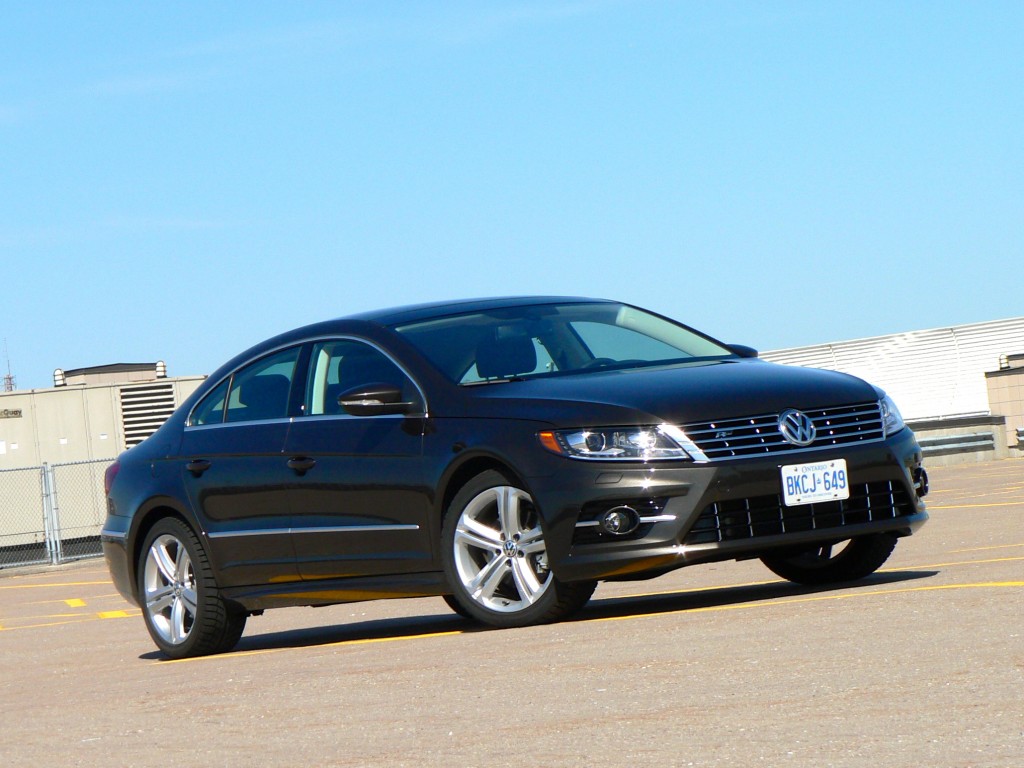Road Test: 2013 Volkswagen CC 2.0 TFSI R-Line
Story and photos by John LeBlanc
There are car geeks, and then there are Volkswagen geeks: Hardcore fans of the German brand that not only obsess over their vehicles’ quirky, European qualities — like diesel engines, manual gearboxes and sophisticated road manners — but also the weird stuff — like felt-lined door pockets, damped glove box doors and concealed trunk hinges — that make a VW, well, a VW.
Lately, though, the VW geek squad has had less to be obsessed about. The German brand’s parent Volkswagen Group (that owns a fleet of brands worldwide, including Audi, Lamborghini and Porsche in Canada) has ambitions to beat out America’s General Motors and Japan’s Toyota for the title of world’s largest automaker. Part of that plan has called for sneaking vehicles that old school worshippers have a hard time getting their brains wrapped around into North American VW showrooms. Cars like the current Mexican-made Jetta and U.S.-built Passat sedans, for example, designed not for fans of European cars, but for less-obsessive mass market buyers in North America and China — many of whom may have never run their hands along the underside of a finished trunk lid.
But VW hasn’t left its faithful totally for dead. Take for example my 2013 Volkswagen CC tester. Like the current Golf/GTI, Tiguan and Touareg, the CC is still considered a “real VW.” First seen in 2008, the European-built CC is another one of these swoopy-roofed four-door sedans that get away being called “four-door coupés,” the product of the sales success of the original (and equally oxymoronic) 2004 Mercedes-Benz CLS.

Just as the Benz CLS is based on the roomier and more formally styled E-Class four-door sedan, the sexy-looking VW CC uses the same chassis as the European version of the Passat. For 2013, the CC gets a relatively major refresh. The car was arguably already the best-looking vehicle in VW’s showrooms, but now its front exterior design has been made sharper to make it fall inline with current VW models. While inside, VW has re-contoured the CC’s rear seat setup to allow for three-across seating compared to the original’s two rear passenger limit.
Fans of the last-generation Passat will feel at home inside the CC. Beyond the fit and finish comparable to costlier luxury brands, the VW four-door coupé’s cabin is a step above rivals like the Acura TSX and Buick Regal. Solid ergonomics are also on board. And all the driver’s controls are logically laid out and easy to use.
Under the CC’s hood, you can still opt for either four or six-cylinder gas engines. The $36,520 (all prices include a $1,395 freight and pre-delivery inspection charge) base CC Sportline uses VW’s ubiquitous turbocharged 2.0-litre four mated to a six-speed manual gearbox and sending power only to its front wheels. My mid-level $41,370 Highline added a six-speed dual-clutch automatic, R-Line trim (larger 18-inch wheels, sports steering wheel with paddle shifters, aluminum door sills, body kit) and a Technology package (navigation, upgraded audio) to ring in at $47,370. There’s also a topline all-wheel-drive, six-cylinder CC Highline V6 4Motion that starts at $48,475.

Entry-level luxury sedan buyers should be satisfied with the CC turbo-four’s excellent blend of performance (zero to 100 km/h in 6.7 seconds; only 0.3 slower than the V6) and fuel economy. The 2.0 makes 200 horsepower and 207 pound-feet of torque, and scores 9.7 L/100 km city, and 6.6 on the highway. While the 280 hp and 265 lb-ft, 3.6 L six’s figures are 12.7 and 8.3, respectively.
Despite the apparent lack of cylinders and displacement, my CC 2.0 TFSI R-Line’s powertrain was refined — very smooth, quiet and quite responsive, which pretty much sums up the overall driving demeanour of the CC. While VW is not pimping the cars out as sports sedans, the CC’s steering is more accurate than a Regal. And where the TSX will hesitate when you want to clip a corner, the CC eagerly digs in. The CC shines best is as a highway missile, though. Perhaps it’s the VW’s Germanic roots showing through, but this sedan is stealthy fast on the highway, where I caught myself constantly driving 20 km/h faster than usual because of the VW’s hushed cabin.

Compromises in my CC 2.0 TFSI R-Line tester were few. Its curvaceous rear styling obviously comes at the expense of rear headroom. Two passengers instead of three will be happier back there on longer rides. Then there’s the issue of paying nearly $50,000 for a VW with only four cylinders. At that price, some customers may say, “Geez, I could buy a nicely kitted-out Audi A4 for that!” Which you could, but based on the number of CCs sold in Canada last year (1,597) compared to A4s (6,118) you may question, which is the mainstream luxury sedan.
But then, an Audi — or an Acura or Buick — probably isn’t even on the radar for the VW geekdom. For those loyal fans who still appreciate felt-lined door pockets, damped glove box doors and concealed trunk hinges — and looking for a luxury sedan — hopefully the German automaker will continue to build its über-VW CC.
THE SPECS
Type of vehicle Front-wheel-drive full sized sedan
Engine 2.0L DOHC turbocharged four-cylinder
Power 200 hp @ 5,100 rpm, 207 lb-ft of torque @ 1,700 rpm
Transmission Six-speed dual-clutch automatic
Brakes Four-wheel disc with ABS
Tires P235/40R18
Base price/as tested $41,375/$45,975
Destination charge $1,395
Natural Resources Canada fuel consumption L/100 km 9.7 city; 6.6 hwy; 8.8 as-tested
Standard features Premium audio system with a six-CD changer and touch-screen controls with a media interface with an iPod cable; cruise control; leatherette seats with power adjustment up front; rear-seat pass-through; trip computer; power tilting-and-sliding glass sunroof






![[del.icio.us]](https://www.straight-six.com/wp-content/plugins/bookmarkify/delicious.png)
![[Digg]](https://www.straight-six.com/wp-content/plugins/bookmarkify/digg.png)
![[Facebook]](https://www.straight-six.com/wp-content/plugins/bookmarkify/facebook.png)
![[Google]](https://www.straight-six.com/wp-content/plugins/bookmarkify/google.png)
![[Reddit]](https://www.straight-six.com/wp-content/plugins/bookmarkify/reddit.png)
![[StumbleUpon]](https://www.straight-six.com/wp-content/plugins/bookmarkify/stumbleupon.png)
![[Twitter]](https://www.straight-six.com/wp-content/plugins/bookmarkify/twitter.png)
![[Email]](https://www.straight-six.com/wp-content/plugins/bookmarkify/email.png)